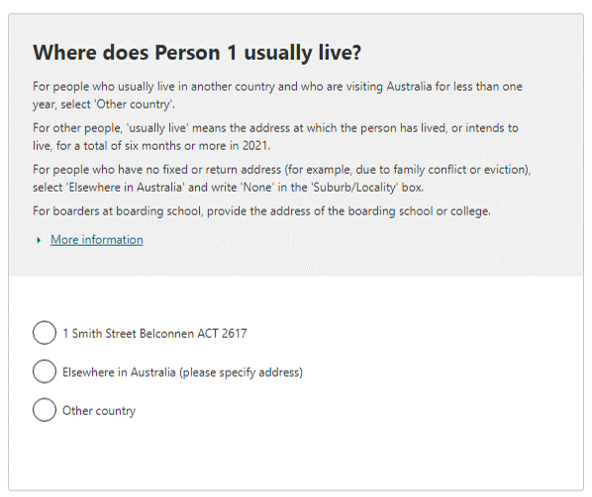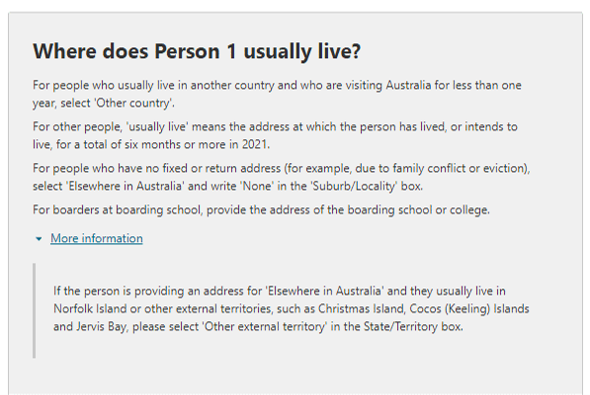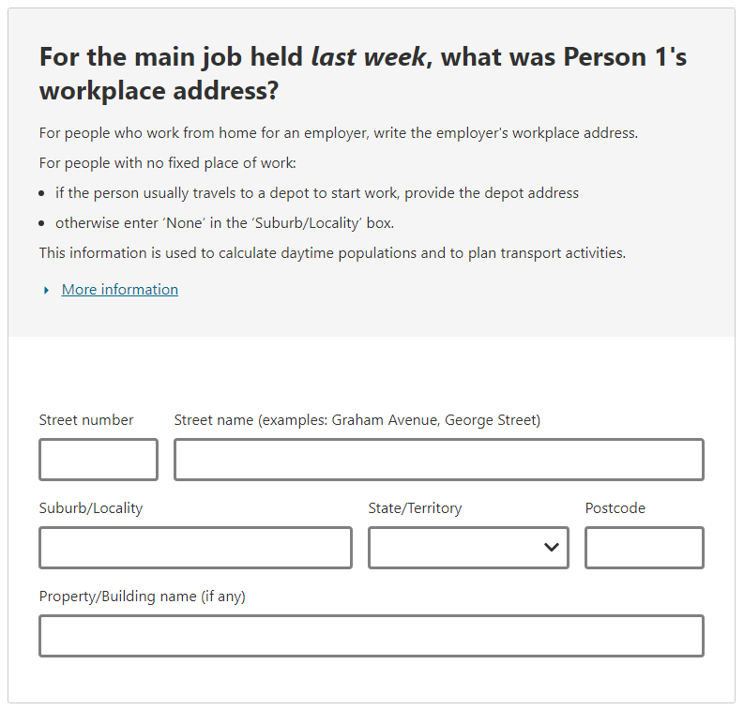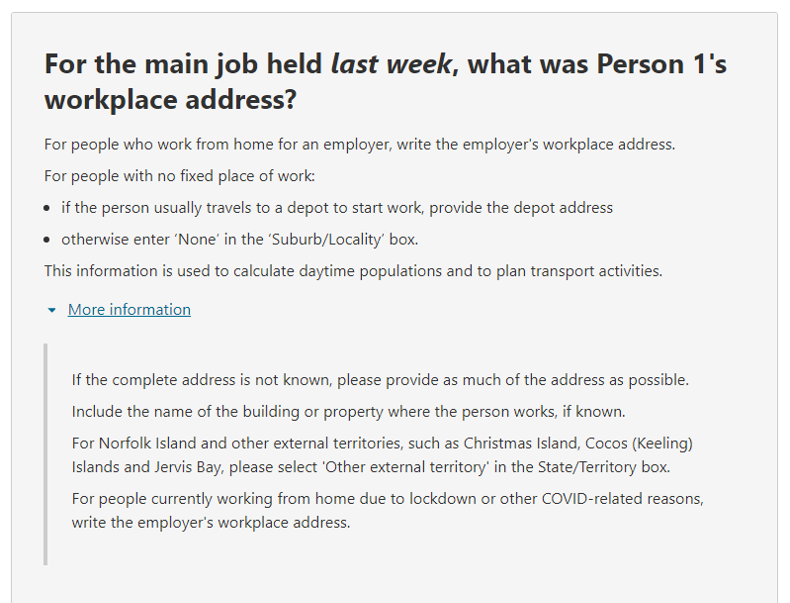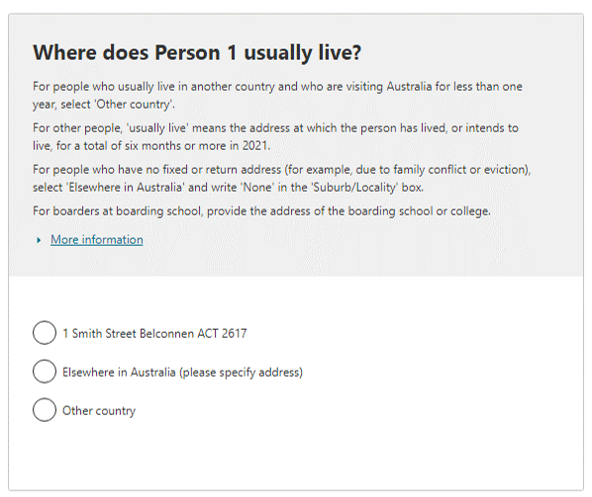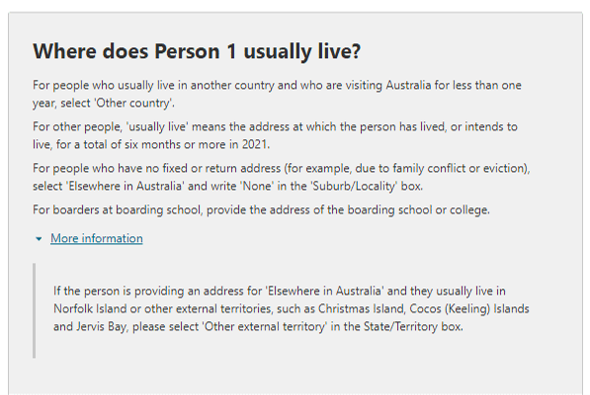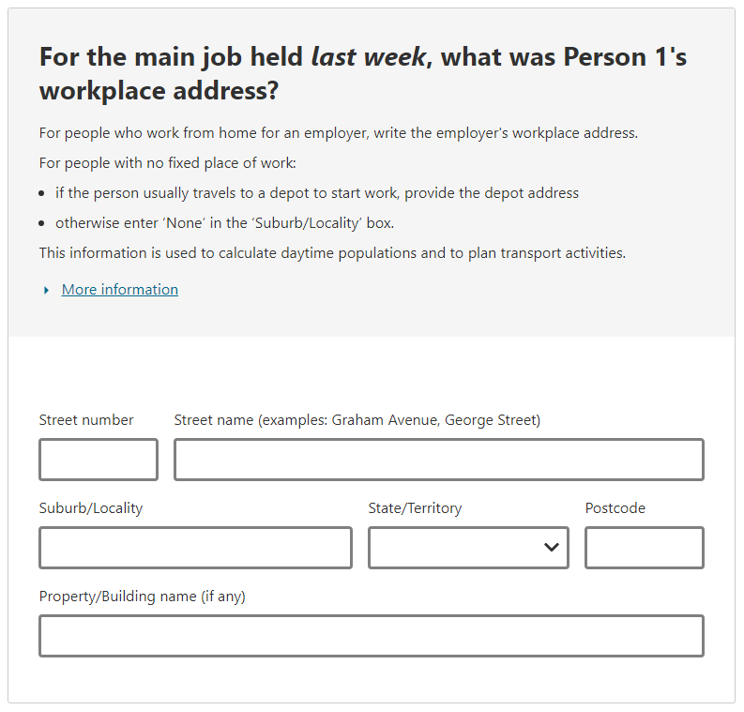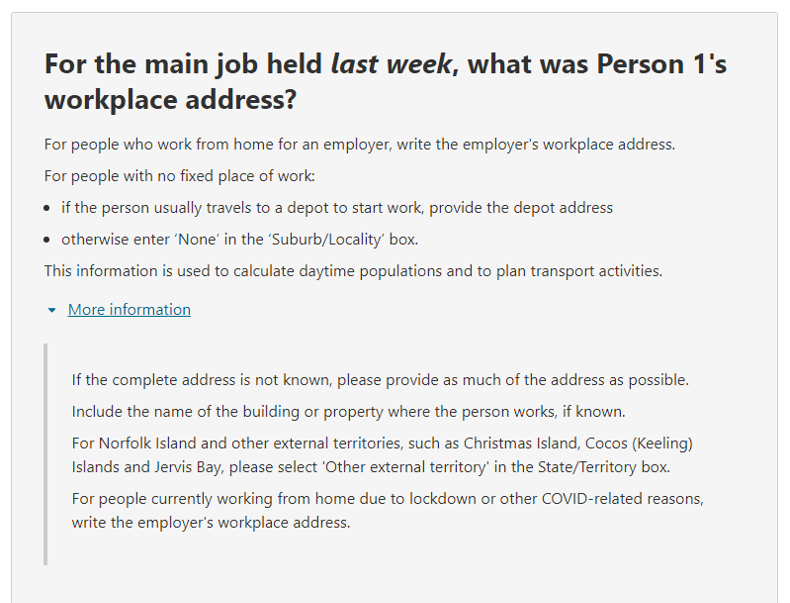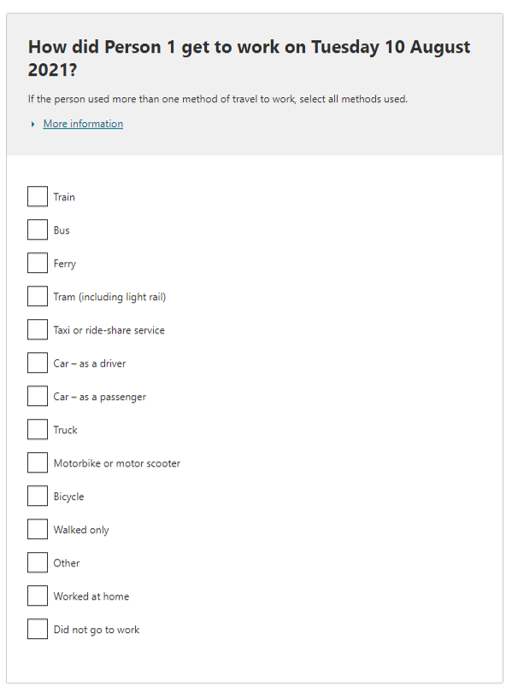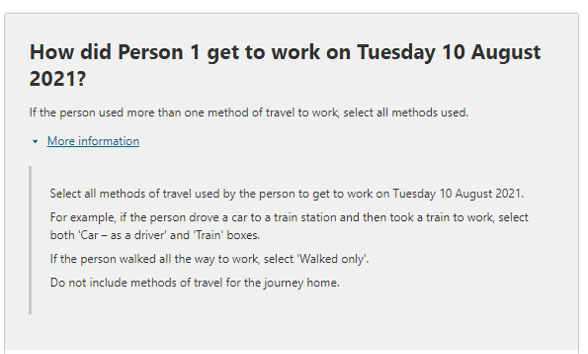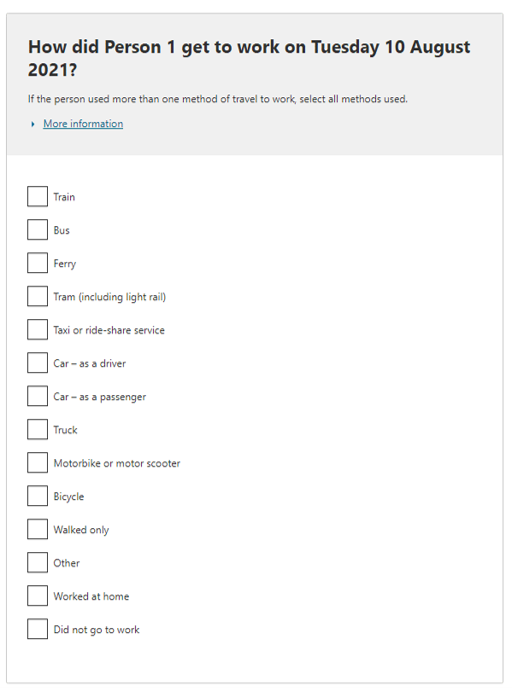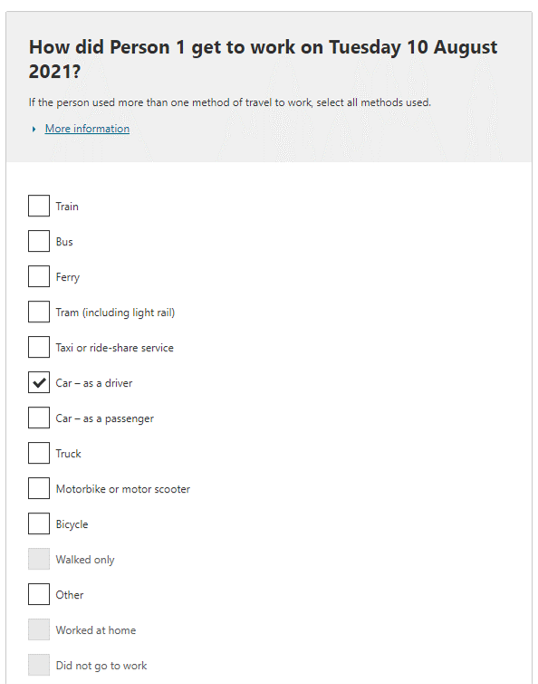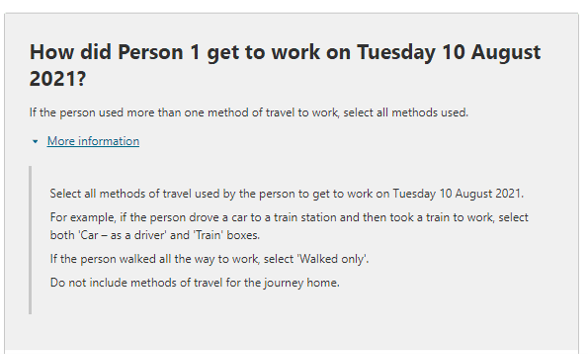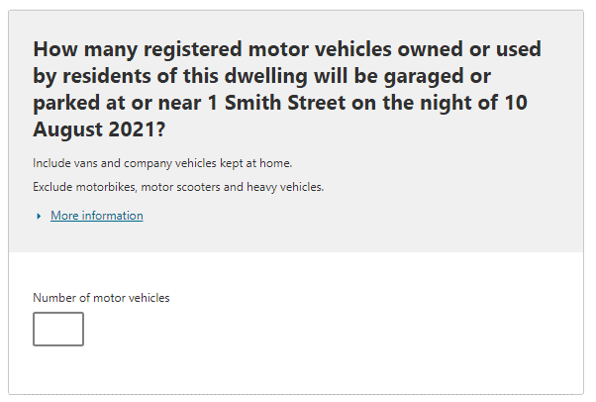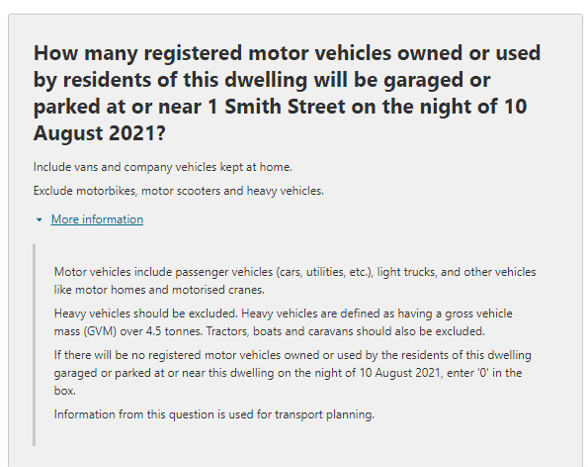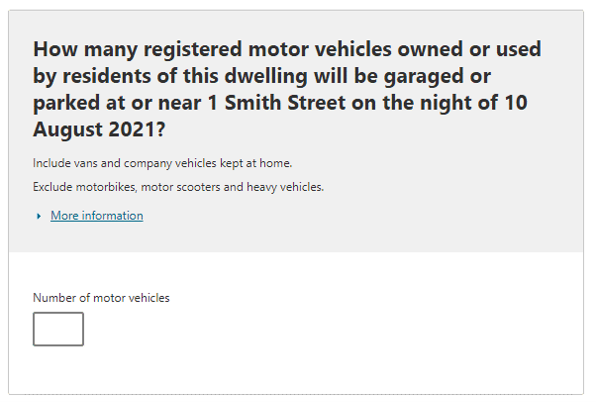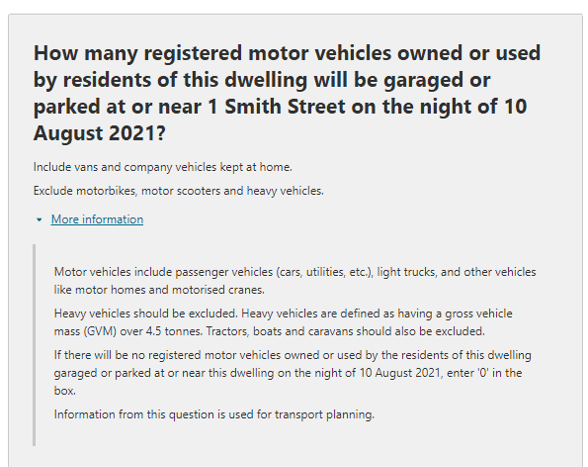| 1 Public Transport | | | |
| | 01 Train | | |
| | | 001 | Train |
| | | 012 | Train, bus |
| | | 013 | Train, ferry |
| | | 014 | Train, tram/light rail |
| | | 015 | Train, taxi/ride-share service |
| | | 016 | Train, car as driver |
| | | 017 | Train, car as passenger |
| | | 018 | Train, truck |
| | | 019 | Train, motorbike/scooter |
| | | 020 | Train, bicycle |
| | | 021 | Train, other |
| | | 067 | Train, bus, ferry |
| | | 068 | Train, bus, tram/light rail |
| | | 069 | Train, bus, taxi/ride-share service |
| | | 070 | Train, bus, car as driver |
| | | 071 | Train, bus, car as passenger |
| | | 072 | Train, bus, truck |
| | | 073 | Train, bus, motorbike/scooter |
| | | 074 | Train, bus, bicycle |
| | | 075 | Train, bus, other |
| | | 076 | Train, ferry, tram/light rail |
| | | 077 | Train, ferry, taxi/ride-share service |
| | | 078 | Train, ferry, car as driver |
| | | 079 | Train, ferry, car as passenger |
| | | 080 | Train, ferry, truck |
| | | 081 | Train, ferry, motorbike/scooter |
| | | 082 | Train, ferry, bicycle |
| | | 083 | Train, ferry, other |
| | | 084 | Train, tram/light rail, taxi/ride-share service |
| | | 085 | Train, tram/light rail, car as driver |
| | | 086 | Train, tram/light rail, car as passenger |
| | | 087 | Train, tram/light rail, truck |
| | | 088 | Train, tram/light rail, motorbike/scooter |
| | | 089 | Train, tram/light rail, bicycle |
| | | 090 | Train, tram/light rail, other |
| | | 091 | Train, taxi/ride-share service, car as driver |
| | | 092 | Train, taxi/ride-share service, car as passenger |
| | | 093 | Train, taxi/ride-share service, truck |
| | | 094 | Train, taxi/ride-share service, motorbike/scooter |
| | | 095 | Train, taxi/ride-share service, bicycle |
| | | 096 | Train, taxi/ride-share service, other |
| | | 097 | Train, car as driver, car as passenger |
| | | 098 | Train, car as driver, truck |
| | | 099 | Train, car as driver, motorbike/scooter |
| | | 100 | Train, car as driver, bicycle |
| | | 101 | Train, car as driver, other |
| | | 102 | Train, car as passenger, truck |
| | | 103 | Train, car as passenger, motorbike/scooter |
| | | 104 | Train, car as passenger, bicycle |
| | | 105 | Train, car as passenger, other |
| | | 106 | Train, truck, motorbike/scooter |
| | | 107 | Train, truck, bicycle |
| | | 108 | Train, truck, other |
| | | 109 | Train, motorbike/scooter, bicycle |
| | | 110 | Train, motorbike/scooter, other |
| | | 111 | Train, bicycle, other |
| | 02 Bus | | |
| | | 002 | Bus |
| | | 022 | Bus, ferry |
| | | 023 | Bus, tram/light rail |
| | | 024 | Bus, taxi/ride-share service |
| | | 025 | Bus, car as driver |
| | | 026 | Bus, car as passenger |
| | | 027 | Bus, truck |
| | | 028 | Bus, motorbike/scooter |
| | | 029 | Bus, bicycle |
| | | 030 | Bus, other |
| | | 112 | Bus, ferry, tram/light rail |
| | | 113 | Bus, ferry, taxi/ride-share service |
| | | 114 | Bus, ferry, car as driver |
| | | 115 | Bus, ferry, car as passenger |
| | | 116 | Bus, ferry, truck |
| | | 117 | Bus, ferry, motorbike/scooter |
| | | 118 | Bus, ferry, bicycle |
| | | 119 | Bus, ferry, other |
| | | 120 | Bus, tram/light rail, taxi/ride-share service |
| | | 121 | Bus, tram/light rail, car as driver |
| | | 122 | Bus, tram/light rail, car as passenger |
| | | 123 | Bus, tram/light rail, truck |
| | | 124 | Bus, tram/light rail, motorbike/scooter |
| | | 125 | Bus, tram/light rail, bicycle |
| | | 126 | Bus, tram/light rail, other |
| | | 127 | Bus, taxi/ride-share service, car as driver |
| | | 128 | Bus, taxi/ride-share service, car as passenger |
| | | 129 | Bus, taxi/ride-share service, truck |
| | | 130 | Bus, taxi/ride-share service, motorbike/scooter |
| | | 131 | Bus, taxi/ride-share service, bicycle |
| | | 132 | Bus, taxi/ride-share service, other |
| | | 133 | Bus, car as driver, car as passenger |
| | | 134 | Bus, car as driver, truck |
| | | 135 | Bus, car as driver, motorbike/scooter |
| | | 136 | Bus, car as driver, bicycle |
| | | 137 | Bus, car as driver, other |
| | | 138 | Bus, car as passenger, truck |
| | | 139 | Bus, car as passenger, motorbike/scooter |
| | | 140 | Bus, car as passenger, bicycle |
| | | 141 | Bus, car as passenger, other |
| | | 142 | Bus, truck, motorbike/scooter |
| | | 143 | Bus, truck, bicycle |
| | | 144 | Bus, truck, other |
| | | 145 | Bus, motorbike/scooter, bicycle |
| | | 146 | Bus, motorbike/scooter, other |
| | | 147 | Bus, bicycle, other |
| | 03 Ferry | | |
| | | 003 | Ferry |
| | | 031 | Ferry, tram/light rail |
| | | 032 | Ferry, taxi/ride-share service |
| | | 033 | Ferry, car as driver |
| | | 034 | Ferry, car as passenger |
| | | 035 | Ferry, truck |
| | | 036 | Ferry, motorbike/scooter |
| | | 037 | Ferry, bicycle |
| | | 038 | Ferry, other |
| | | 148 | Ferry, tram/light rail, taxi/ride-share service |
| | | 149 | Ferry, tram/light rail, car as driver |
| | | 150 | Ferry, tram/light rail, car as passenger |
| | | 151 | Ferry, tram/light rail, truck |
| | | 152 | Ferry, tram/light rail, motorbike/scooter |
| | | 153 | Ferry, tram/light rail, bicycle |
| | | 154 | Ferry, tram/light rail, other |
| | | 155 | Ferry, taxi/ride-share service, car as driver |
| | | 156 | Ferry, taxi/ride-share service, car as passenger |
| | | 157 | Ferry, taxi/ride-share service, truck |
| | | 158 | Ferry, taxi/ride-share service, motorbike/scooter |
| | | 159 | Ferry, taxi/ride-share service, bicycle |
| | | 160 | Ferry, taxi/ride-share service, other |
| | | 161 | Ferry, car as driver, car as passenger |
| | | 162 | Ferry, car as driver, truck |
| | | 163 | Ferry, car as driver, motorbike/scooter |
| | | 164 | Ferry, car as driver, bicycle |
| | | 165 | Ferry, car as driver, other |
| | | 166 | Ferry, car as passenger, truck |
| | | 167 | Ferry, car as passenger, motorbike/scooter |
| | | 168 | Ferry, car as passenger, bicycle |
| | | 169 | Ferry, car as passenger, other |
| | | 170 | Ferry, truck, motorbike/scooter |
| | | 171 | Ferry, truck, bicycle |
| | | 172 | Ferry, truck, other |
| | | 173 | Ferry, motorbike/scooter, bicycle |
| | | 174 | Ferry, motorbike/scooter, other |
| | | 175 | Ferry, bicycle, other |
| | 04 Tram/light rail | | |
| | | 004 | Tram/light rail |
| | | 039 | Tram/light rail, taxi/ride-share service |
| | | 040 | Tram/light rail, car as driver |
| | | 041 | Tram/light rail, car as passenger |
| | | 042 | Tram/light rail, truck |
| | | 043 | Tram/light rail, motorbike/scooter |
| | | 044 | Tram/light rail, bicycle |
| | | 045 | Tram/light rail, other |
| | | 176 | Tram/light rail, taxi/ride-share service, car as driver |
| | | 177 | Tram/light rail, taxi/ride-share service, car as passenger |
| | | 178 | Tram/light rail, taxi/ride-share service, truck |
| | | 179 | Tram/light rail, taxi/ride-share service, motorbike/scooter |
| | | 180 | Tram/light rail, taxi/ride-share service, bicycle |
| | | 181 | Tram/light rail, taxi/ride-share service, other |
| | | 182 | Tram/light rail, car as driver, car as passenger |
| | | 183 | Tram/light rail, car as driver, truck |
| | | 184 | Tram/light rail, car as driver, motorbike/scooter |
| | | 185 | Tram/light rail, car as driver, bicycle |
| | | 186 | Tram/light rail, car as driver, other |
| | | 187 | Tram/light rail, car as passenger, truck |
| | | 188 | Tram/light rail, car as passenger, motorbike/scooter |
| | | 189 | Tram/light rail, car as passenger, bicycle |
| | | 190 | Tram/light rail, car as passenger, other |
| | | 191 | Tram/light rail, truck, motorbike/scooter |
| | | 192 | Tram/light rail, truck, bicycle |
| | | 193 | Tram/light rail, truck, other |
| | | 194 | Tram/light rail, motorbike/scooter, bicycle |
| | | 195 | Tram/light rail, motorbike/scooter, other |
| | | 196 | Tram/light rail, bicycle, other |
| | 05 Taxi/ride-share service | | |
| | | 005 | Taxi/ride-share service |
| | | 046 | Taxi/ride-share service, car as driver |
| | | 047 | Taxi/ride-share service, car as passenger |
| | | 048 | Taxi/ride-share service, truck |
| | | 049 | Taxi/ride-share service, motorbike/scooter |
| | | 050 | Taxi/ride-share service, bicycle |
| | | 051 | Taxi/ride-share service, other |
| | | 197 | Taxi/ride-share service, car as driver, car as passenger |
| | | 198 | Taxi/ride-share service, car as driver, truck |
| | | 199 | Taxi/ride-share service, car as driver, motorbike/scooter |
| | | 200 | Taxi/ride-share service, car as driver, bicycle |
| | | 201 | Taxi/ride-share service, car as driver, other |
| | | 202 | Taxi/ride-share service, car as passenger, truck |
| | | 203 | Taxi/ride-share service, car as passenger, motorbike/scooter |
| | | 204 | Taxi/ride-share service, car as passenger, bicycle |
| | | 205 | Taxi/ride-share service, car as passenger, other |
| | | 206 | Taxi/ride-share service, truck, motorbike/scooter |
| | | 207 | Taxi/ride-share service, truck, bicycle |
| | | 208 | Taxi/ride-share service, truck, other |
| | | 209 | Taxi/ride-share service, motorbike/scooter, bicycle |
| | | 210 | Taxi/ride-share service, motorbike/scooter, other |
| | | 211 | Taxi/ride-share service, bicycle, other |
| 2 Vehicle | | | |
| | 06 Car, as driver | | |
| | | 006 | Car, as driver |
| | | 052 | Car as driver, car as passenger |
| | | 053 | Car as driver, truck |
| | | 054 | Car as driver, motorbike/scooter |
| | | 055 | Car as driver, bicycle |
| | | 056 | Car as driver, other |
| | | 212 | Car as driver, car as passenger, truck |
| | | 213 | Car as driver, car as passenger, motorbike/scooter |
| | | 214 | Car as driver, car as passenger, bicycle |
| | | 215 | Car as driver, car as passenger, other |
| | | 216 | Car as driver, truck, motorbike/scooter |
| | | 217 | Car as driver, truck, bicycle |
| | | 218 | Car as driver, truck, other |
| | | 219 | Car as driver, motorbike/scooter, bicycle |
| | | 220 | Car as driver, motorbike/scooter, other |
| | | 221 | Car as driver, bicycle, other |
| | 07 Car, as passenger | | |
| | | 007 | Car, as passenger |
| | | 057 | Car as passenger, truck |
| | | 058 | Car as passenger, motorbike/scooter |
| | | 059 | Car as passenger, bicycle |
| | | 060 | Car as passenger, other |
| | | 222 | Car as passenger, truck, motorbike/scooter |
| | | 223 | Car as passenger, truck, bicycle |
| | | 224 | Car as passenger, truck, other |
| | | 225 | Car as passenger, motorbike/scooter, bicycle |
| | | 226 | Car as passenger, motorbike/scooter, other |
| | | 227 | Car as passenger, bicycle, other |
| | 08 Truck | | |
| | | 008 | Truck |
| | | 061 | Truck, motorbike/scooter |
| | | 062 | Truck, bicycle |
| | | 063 | Truck, other |
| | | 228 | Truck, motorbike/scooter, bicycle |
| | | 229 | Truck, motorbike/scooter, other |
| | | 230 | Truck, bicycle, other |
| | 09 Motorbike/scooter | | |
| | | 009 | Motorbike/scooter |
| | | 064 | Motorbike/scooter, bicycle |
| | | 065 | Motorbike/scooter, other |
| | | 231 | Motorbike/scooter, bicycle, other |
| 3 Active Transport | | | |
| | 10 Bicycle | | |
| | | 010 | Bicycle |
| | | 066 | Bicycle, other |
| | 11 Walked only | | |
| | | 232 | Walked only |
| 4 Other Mode | | | |
| | 12 Other Mode | | |
| | | 011 | Other |
| 5 Worked at home or Did not go to work | | | |
| | 13 Worked at home | | |
| | | 233 | Worked at home |
| | 14 Did not go to work | | |
| | | 234 | Did not go to work |
| 6 Mode not stated | | | |
| | 15 Not stated | | |
| | | &&& | Not stated |
| @ Not applicable | | | |
| | @@ Not applicable | | |
| | | @@@ | Not applicable |
| V Overseas visitor | | | |
| | VV Overseas visitor | | |
| | | VVV | Overseas visitor |
